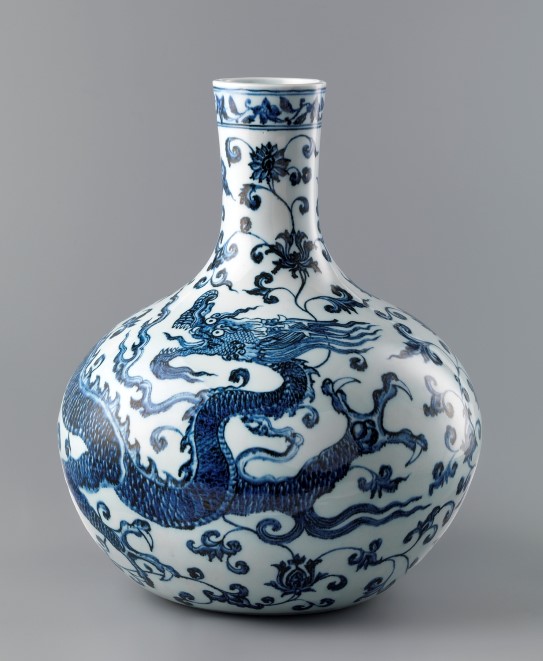Vase (audio description)
Unidentified artist
Transcription
Description
Vase with dragon motif
Probably from the early 1400s
The vase is forty-two centimeters high. It has a thick "body" and a slim neck at the top. The neck makes up half of the vase height. The vase is in white porcelain with decoration in cobalt, which (depending on the thickness it is applied in) varies from clear blue to gray-black. A sizzling dragon with curly tongue and large claws meanders horizontally over the center of the vase, around which are stylized plant motifs.
Narrator:
This rare dragon vase is 600 years old. But its sparkling blue and white decoration is as clear as ever.
The vase was already an exclusive item when it left the potter’s wheel. It was made to fulfil an order from an emperor of the Ming dynasty, at a time when China was the world’s only producer of porcelain. Peder Valle, an art historian at the National Museum, takes us on a journey to the porcelain city:
Peder Valle:
Many travellers, including explorers from as far away as Europe, found their way to Jingdezhen. We have their descriptions of the city, which tell us that as many as a million people lived there, and that there were more than 1,000 kilns operating day and night. (Audio pause 1.5 sec) When the kilns were being fired at night, the city appeared to be ablaze. Sometimes, throughout the year, it never really got light, because of all the smoke from the kilns.
Narrator:
This was the city where craftsmen were assigned the technically demanding task of creating this fragile vase – a true masterpiece. And they would only have been able to see the result when it was taken out of the kiln.
Were they successful?
Inspect it more closely yourself.
The lively dragon, which symbolizes the emperor, is a celestial being associated with good luck and happiness.
Peder Valle:
A dragon is a remarkable legendary creature that is said to be made up of parts from nine other animals. For example, it has the body of a snake and the scales of a fish. And so dragons are creatures of legend. They never actually existed in the real world. Rather, they are mythological and cultural beings. Here the dragon winds its long, scaly sinuous body all the way around the vase, turning its head to look backwards with its jaws gaping open. It’s almost as though we can feel and hear the dragon’s roar. However, according to Chinese mythology, a dragon’s roar sounded like gurgling water. So perhaps this dragon isn’t roaring quite in the way we might imagine.